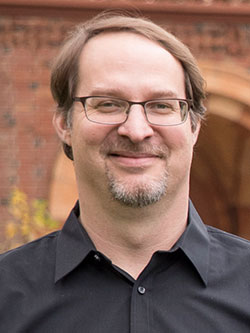
Dr. Eric Bartelink
Human ID Lab Co-Director
- Email: ebartelink@csuchico.edu
- Phone: 530-898-4905
- Location: Plumas Hall 107
Areas of Concentration
Physical: bioarchaeology, paleodietary reconstruction, forensic anthropology, California prehistory
Curriculum Vitae: Eric Bartelink (PDF)
I am a Professor of Physical Anthropology and serve as the Director of the CSU-Chico Human Identification Laboratory (CSUC-HIL), the Stable Isotope Preparation Laboratory (SIPL), and the co-coordinator of the Certificate in Forensic Identification. I am a board-certified Diplomate of the American Board of Forensic Anthropology(opens in new window) (D-ABFA Certificate #89).
I teach undergraduate and graduate-level coursework in introductory physical anthropology, human osteology, forensic anthropology, bioarchaeology, human growth and development, and statistics. I am a certified instructor for POST (Peace Officer Standards and Training), and teach short courses and workshops in forensic anthropology, forensic archaeology, and human versus nonhuman bone identification. I am a forensic specialist for California’s NamUs (opens in new window)team (National Missing and Unidentified Persons System), and a member of the Anthropology Subcommittee of the Organization of Scientific Area Committees (OSAC) through NIST.
The CSU-Chico Human ID Lab regularly consults with local and state agencies in forensic anthropological analysis and scene recovery. Graduate students and forensic certificate interns gain practical hands-on experience in forensic anthropology casework, forensic scene recovery, bioarchaeology, and zooarchaeology
Bioarchaeological Interests
I completed my doctoral work in biological anthropology at Texas A&M University (2006). My bioarchaeological research examines ancient human diet as well as the paleopathology and paleonutrition of hunter-gatherer populations from the San Francisco Bay Area, Sacramento Valley, and Monterey Bay area of central California. My research focuses on the analysis and interaction of diet, stress, and skeletal health within prehistoric populations as studied through stable isotope analysis and paleopathological and nutritional stress indicators. I have conducted research on prehistoric and historic human skeletal remains from California, American Samoa, and Nevada.
Forensic Anthropology Interests
My interests in forensic anthropology relate to the use of stable isotope analysis for the identification of unknown individuals, taphonomy (e.g., cremains, animal scavenging, and fluvial transport), and trauma analysis. In the past, I assisted with mass grave excavations in Bosnia-Herzegovina for the United Nations ICTY forensic team (2000) and in the World Trade Center Victim Identification effort (2002-2003) in New York City.
